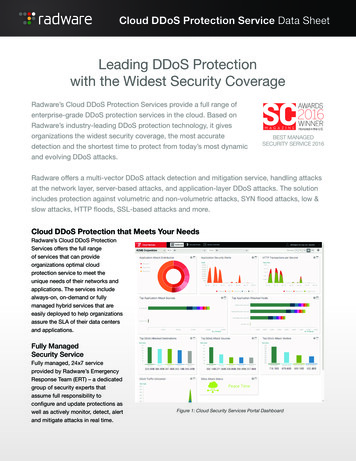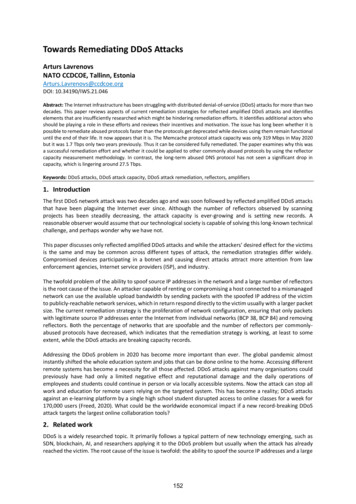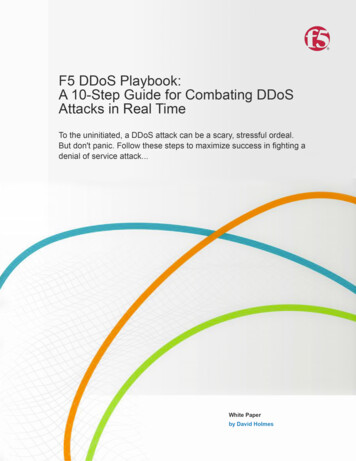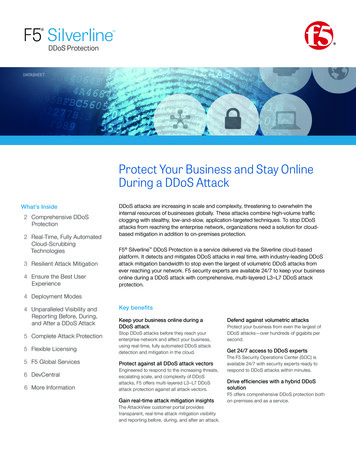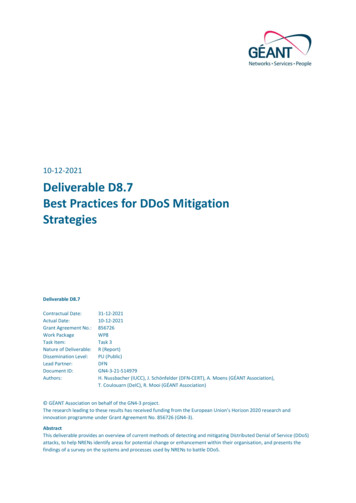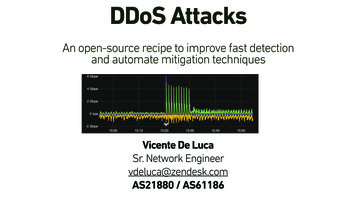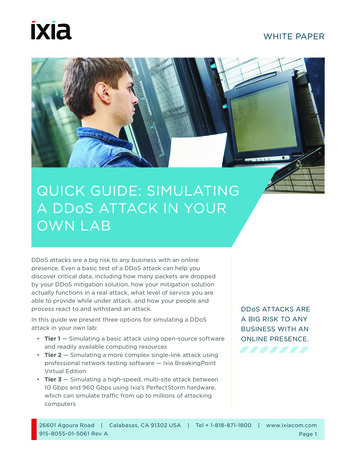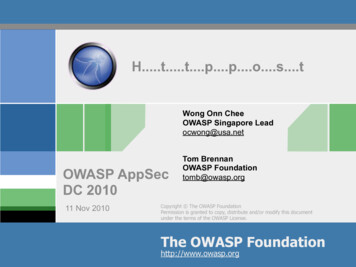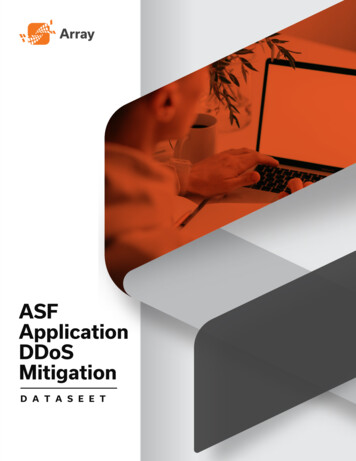
Transcription
ASFApplicationDDoSMitigationD A T A S E E T
ASF Series Application Security Firewallprovides enterprise-grade application DDoS(Distributed Denial of Service) mitigationsolution, which helps defend critical businessapplications in the enterprise data centerfrom DDoS attacks and other threats.Array Networks ASF Series employ the sophisticated 64-bitSpeedCore multi-coreprocessingcomprehensive and accuratedetection and rovidingDoS and DDoS attack inspection,business-critical applications. Thegranular attackmitigationcontrol andattack detection accuracy and minimize false positives withthe traffic baseline learning feature, dynamic refreshing of defenseprofile based on the learned traffic baseline, and the client sourceverification function.
Product Function DescriptionCombination of Detection and CleaningASF Series provides a high-performance DDoS engine with stateless technology, which can accuratelydetect and identify Layer 3 to Layer 7 DDoS attacks and DoS attacks with the help of session tracking andsource verification mechanisms.After detecting DDoS attacks, ASF Series will generate and execute automatic blacklist to quickly clean themalicious traffic in the mixed traffic for the defense objects.In addition, ASF Series allows attack detection and traffic cleaning to be deployed together or separately.Enterprise-grade DDoS MitigationASF Series provide Layer 3 to Layer 7 DDoS mitigation, capable of mitigating volumetric DDoSattacks, protocol-based DDoS attacks, and application layer attacks with latency of microseconds.ASF Series supports providing granular and unique DDoS mitigation for different applications using DDoSprofiles. Once defense objects are created, automatic DDoS profiles will provide the default DDoS mitigationfor them. The traffic baseline learning function then allows the appliance to learn the traffic baseline of theapplications and thus dynamic refresh the defense parameters for the automatic profiles. In this way, theautomatic profiles can adapt to the traffic pattern changes with time agilely and achieve accurate DDoSidentification and mitigation including defense against “Zero-day”.To maximize the defense accuracy including BOT protection and reduce false positives, ASF Series supportsmultiple source verification mechanisms, such as CAPTCHA, session tracking, and first packet drop.The DoS and DDoS attacks that ASF Series can mitigate include but not limited to: HTTP GET Flood TCP ACK Flood HTTP POST Flood TCP FIN/RST Flood HTTP Slowloris TCP Connection Exhaustion HTTP Slow POST TCP Fragment Flood HTTP Challenge Collapsar (CC) TCP Slow Connection attack HTTP packet anomalies TCP Abnormal Connection attack SSL Handshake attack UDP Flood SSL Renegotiation attack UDP Fragment Flood SSL packet anomalies ICMP Flood DNS Query Flood Smurf, Ping of Death, LAND, IP Spoofing, Teardrop, DNS Reply FloodFraggle, Winnuke, Tracert and other malformed DNS NXDomain Floodsingle-packet attacks DNS Cache Poisoning DNS packet anomalies TCP SYN Flood TCP SYN-ACK Flood
Flexible Deployment OptionsASF Series provide flexible deployment options to meet various customer network situations. ASF Seriessupport the following deployment mode:Bridge transparent mode: ASF connects the network transparently on layer 2. The administrator does notneed to change anyconfiguration of the network. Besides, this mode supports the Bypass function, butdoes not support HTTPS application defense.Bridge proxy mode: ASF connects the network transparently on layer 2. The administrator needs to modifythe network’s NAT/Route configurations or DNS resource records to direct the application traffic to the virtualservice IP to make sure thatthe application traffic passes through the ASF appliance physically.Routing transparent mode: ASF connects the network on layer 3. The administrator needs to draw therequests and responses of the application traffic to the Uplink and Downlink interfaces respectively.Routing proxy mode: ASF connects the network transparently on layer 3. The administrator needs to modifythe network’s NAT/Route configuration or DNS resource records to draw the application traffic to the virtualservice IP and modify the route configuration of the server to route server responses to the ASF Downlinkinterface.Out-of-path and TAP mode: The ASF appliance is deployed out of the traffic path. The administrator needsto configure a port mirroring policy on the switch that ASF connects to copy the traffic to the ASF appliancefor detection. This mode only detects attacks but does not block attacks. In addition, it does not supportHTTPS application defense.In addition, ASF Series support traffic diversion, which diverts suspicious traffic to the ASF appliance forinspection based on policy and BGP routing. ASF Series support traffic injection to inject normal traffic back tothe network after cleaning malicious traffic based on policy routing.SSL OffloadASF Series provide hardware SSL or software based SSL offload capability, which migrate the computingintensive SSL encryption and decryption workload to the ASF appliances, thus reducing the workload ofbackend servers and enhancing server performance.With SSL offload capability, ASF Series can perform deep inspection on the HTTP packets, which makeattacks employing encryption methods nowhere to hide.ASF Series support RSA, ECC and SM2 certifications and TLSv1.2, TLSv1.1, TLSv1.0 and SSLv3.0protocols.Client authentication and session reuse are supported.
Comprehensive Web SecurityBesides the DDoS/DoS attacks, customers’ applications are also confronted with all kinds of Web attacks,such as SQL injection, XSS, cookie/session hijacking, parameter tampering and so on.ASF Series also integrated the Web Application Firewall (WAF) module with the DDoS mitigation. The WAFmodule support negative and positive security model. The negative security model supports signature-baseddefense, data leakage prevention, CSRF defense, anti-crawling/scanning, content filtering, and virtualpatching. The positive model supports learning the application characteristics and user behaviors andgenerating positive whitelists to allow only normal traffic to pass and deny all the other traffic. ASF appliance ispreinstalled with Attack Signature Library (ASL), which can be updated manually or automatically. ArrayNetworks release ASL at a regular basis.ASF Series provide HTTP security profile to execute HTTP protocol compliance checks and provide moreHTTP security options to harden the security of applications. In addition, ASF Series provide application ratelimit ACL to ensure the stable running of the applications.Application Security Visibility Providing rich event logs to facilitate the replay and audit of attacks. Providing DDoS attacks as well as HTTP access logs and other types of HTTP violation logs. Supporting exporting security event logs. Providing granular and intuitive graphic monitoring. Displaying real-time and historical system status such as CPU usage, RAM usage, disk usage and throughput. Displaying attack statistics, covering severity distribution, attack type, attack sources, attack source regions and so on. Displaying service traffic statistics, including detailed statistics for the traffic of different protocols. Displaying packet drop statistics including the drop reason statistics. Displaying service access statistics, including the TopN accessed URLs, client IPs and so on. Supporting custom monitoring pages allowing administrators to manage desired monitoring graphs. Supporting exporting monitoring graphs manually and generating monitoring report periodically. Supporting generating advanced system status, application security status, and PCI DSS compliance reports.High AvailabilityASF Series provide multiple high availability options through which the application online time can be maximizedand ensures the high availability of application services. The Clustering function provides fast failover for the two or multiple ASF appliances deployed in routing mode.The ASF appliances can work in active-standby or active-active mode. In a network environment deployed with redundancy solution, the administrator can use the external HA solutionto provide traffic high availability for the ASF appliance deployed in Bridge transparent or proxy mode Software and hardware bypass functions can avoid traffic interruption caused by failure (such as software andhardware failures) for the ASF appliance deployed in Bridge transparent mode. If the ASF appliance is deployed in out-of-path TAP mode, the appliance failure will not lead to service interruption.
Management and IntegrationASF Series are easy to deploy, providing intuitive Web User Interface and easy-to-operate command lineinterface for configuration management. With the admin tools, network administrators can view the status ofsystem parameters, enable services and implement configuration automation by employing the XML-RPCtechnology. By employing extensible API interface, administrators can integrate the system management withthe 3rd-party monitoring and management system.To meet the deployment and management requirements of application security in the cloud, Array’s eCloudAPI provides a script-level interface for cloud management systems to manage and monitor Array devices andassist in interactions between cloud operating systems and virtual machines running Array DDoS mitigation.Physical & Virtual AppliancesDedicated ASF Series appliances leverage a multi-core architecture, SSDs, software or hardware SSL andcompression, energy-efficient components and 10 GigE or 40 GigE to create solutions purpose-built forscalable application security.Whether running on Array’s AVX Series Network Functions Platform, on common hypervisors or on manypopular public cloud marketplaces, vASF virtual appliances are ideal for organizations seeking to benefit fromthe flexibility of virtual environments,offer infrastructure services and new elastic business models or evaluate Array security firewall with minimalrisk and up-front cost.
Product FunctionListAPPLICATION DDOS MITIGATIONHTTP DDoS Mitigation HTTP GET Flood, HTTP POST flood, HTTP Slowloris attack, HTTP Slow POST attack HTTP Packet Anomaly attack (Anomaly method, Anomaly request-line, Anomaly host,Anomaly connection, Anomaly content-length, Anomaly range) HTTP source verificationSSL DDoS Mitigation SSL Handshake attack, SSL Renegotiation (asymmetry) attack SSL Packet Anomaly attack (cipher suites mismatch, handshake version mismatch,record version bad, record type bad, handshake type bad, handshake length bad,encrypt/decrypt error, ssl host stop, send data error, cipher suites bad, send data tocard/sw error, get random error, big number operation failed) Session trackingDNS DDoS Mitigation DNS Query Flood, DNS Reply Flood, DNS NXDomain Flood, DNS Cache Poisoning DNS packet length check, DNS TTL check DNS Packet Anomaly attack (Message length out of limit, IP TTL out of limit, SrcPort& DstPort both 53, Header too short, Invalid opcode, Unused flag set, Invalid rcode,Null query, ANCOUNT is not zero in DNS query, AA bit set in DNS query, TC bit set inDNS query, RA bit set in DNS query, Unexpected end, Pointer loop, Null name, Labellength error, Label length too large, Invalid label type, RR TYPE error, reserved for QTYPEonly, RR CLASS error, QTYPE ANY in DNS query, CLASS is not IN) DNS source verificationAdvanced Web SecurityApplication ACL Signature-based defense, Cookie/session tampering defense, CSRF defense,crawling/scanning defense, virtual patching, HTTP protocol compliance checks, Bruteforce defense, Web antidefacement, Signature Library manual/auto update, CustomSignatures, Error page customization HTTP Rate Limit ACL, DNS Rate Limit ACL, URL Whitelist Automatic IP whitelist/blacklistSSL Acceleration Hardware SSL acceleration, RSA/ECC/SM2 certification, SSLv3/TLSv1/TLSv1.1/TLSv1.2,and custom cipher suites Client certificate authentication, Session reuse
NETWORK DDOS MITIGATIONTCP/UDP/ICMP DDoSmitigation TCP SYN Flood, TCP SYN-ACK Flood, TCP ACK Flood, TCP FIN/RST Flood, TCPConnection Flood, TCP Fragment Flood, TCP Slow Connection, TCP AbnormalConnection UDP Flood, UDP Fragment Flood, ICMP Flood Source verification, Session tracking IP reputationDefense Against DoSand Malformed packets Smurf, LAND, Fraggle, IP Spoofing, Ping of Death, Teardrop, WinNuke, Tracert IP packet with routing record option, IP packet with source routing option, IP packetwith Timestamp option, TCP packet with abnormal flag, large UDP packet, ICMPredirect packet, ICMP unreachable packet, large ICMP packetNetwork ACL TCP Rate Limit ACL, UDP Rate Limit ACL, ICMP Rate Limit ACL Manual IP whitelist/blacklist, Automatic IP whitelist/blacklist, Geolocation-based IPblacklistPOLICY ENFORCEMENTDefense Object Security Service: provides application DDoS defense for it. Security Group: provides network DDoS defense for it.Profile Automatic DDoS profile/Manual DDoS Profile Application/network DDoS profile Defense Mode – Block , detectDynamic Profiling Application Traffic Baseline learning Network Traffic Baseline learning Dynamic refreshing of automatic DDoS profile based on learning resultsAPPLICATION SECURITY VISIBILITYEvent Logs DDoS Attack logs, DDoS Warning logs HTTP violation logs (WAF logs, filter logs, audit logs) Log aggregation
Security alert via Email/SNMP Exporting logs to external Syslog serversGraphic Monitoring Global attack statistics, security group attack statistics, security service attack statistics Global traffic statistics, security group/service traffic statistics Global drop statistics, security group/service drop statistics CPU usage, memory usage, disk usage, throughput Custom monitoring graphsReporting System status monitoring reports, service security status report, PCI DSS compliancereport Report customization, periodic report generationAPPLICATION AVAILABILITYNetworking andDeployment Link aggregation, VLAN, MNET, symmetric and asymmetric traffic Bridge mode, Routing mode, TAP mode; transparent and proxy defense model,out-of-path mode Static routing, RIP/OSPF/BGP dynamic routing, policy routeHigh Availability Clustering among up to 32 nodes, Active/Active or Active/Standby working mode Configuration synchronization Hardware bypass, software bypassIPv6 Full IPv6 support, IPv4 and IPv6 dual stack IPv6-ready gold certifiedMANAGEMENTSystem Secure and intuitive CLI, WebUI and SSH remote management Supporting XML-RPC remote management interfaces
Supporting SNMPv2, SNMPv3 and private MIB file Syslog (based on UDP or TCP) User management, admin authentication and authorization, role-based privilegemanagement, admin audit logs System alert via Email and SNMP Online troubleshooting and real-time monitoringeCloud REST API Interface for cloud management systems to control and monitor hardware and virtualASF appliances Assists interaction between components such as virtual machines in CloudOS Remote management of ASF appliances Notification of events on ASF appliancesApplication DDoS MitigationDeployment ScenarioNetwork 1Network 2Bad NetworkInternetWebAppvASF
TechnicalSpecifications Standard o OptionalASF 2800SeriesASF 5800SeriesASF 7800SeriesASF 9800Series5 Gbps10 Gbps20 Gbps40 Gbps80 GbpsSSL TPS (RSA 2K)15 K15 K40 K55 k110 K/220KMax. ECC TPS(ECDSA P256)14 K14 K28 K38 K76 K/152KBypass CardOptionalASF 1800SeriesMax Throughput1 GbE Copper 1 GbE Fibero10 GbE Fiber 40 GbE FiberPower supplyWeight oDual Power: 100-240VAC, 8-4A, 50-60HzDual Power: 100-240VAC, 10-5A,50-60Hz18.4 lbs.29.6 lbs.18.4 lbs.18.4 lbs.29.6 lbs.Dimensions1U –17”Wx 19.875” D x 1.75” HManagementSSH CLI, Direct Console DB9 CLI, SNMP, Single Console per Cluster, XML-RPC, Out of BandManagement – RJ45/DB9EnvironmentalRegulatory ComplianceSafetySupportWarranty2U – 17” W x 22.5” D x 3.5” HOperating Temperature: 0 to 45 C; Humidity: 0% to 90%; Non-condensingICES-003, EN 55024, CISPR 22, AS/NZS 3548, FCC, 47FR part 15 Class A, VCCI-ACSA, C/US, CE, IEC 60950-1, CSA 60950-1, EN 60950-1Support Gold, Silver and Bronze Level Support Plans1 Year Hardware, 90 Days SoftwarevASFVirtual version vASF (vDDoS)supports all featuresSupported Hypervisors (64-bit only)Virtual Machine Requirements Array AVX Series VMwa Xi 5.5 or Later KVM 1.1.1-1.8.1 or laterSupports at least 2 Virtual CPUsRequires Minimum: 2GB RAM 40GB Disk
VERSION: SEP-2020-REV-A1371 McCarthy Blvd.Milpitas, CA 95035www.arraynetworks.com 1-866-MY-ARRAY 1 408-240-8700 2022 Array Networks, Inc. All rights reserved. Array Networks, the Array Networks logo, AppVelocity, eCloud, ePolicy, eRoute, SpeedCore andWebWall are all trademarks of Array Networks, Inc. in the United States and other countries. All other trademarks, service marks, registered marks, orregistered service marks are the property of their respective owners. Array Networks assumes no responsibility for any inaccuracies in this document.Array Networks reserves the right to change, modify, transfer, or otherwise revise this publication without notice.
ASF Series support RSA, ECC and SM2 certifications and TLSv1.2, TLSv1.1, TLSv1.0 and SSLv3.0 protocols.Client authentication and session reuse are supported. . If the ASF appliance is deployed in out-of-path TAP mode, the appliance failure will not lead to service interruption. High Availability. ASF Series are easy to deploy, providing .


